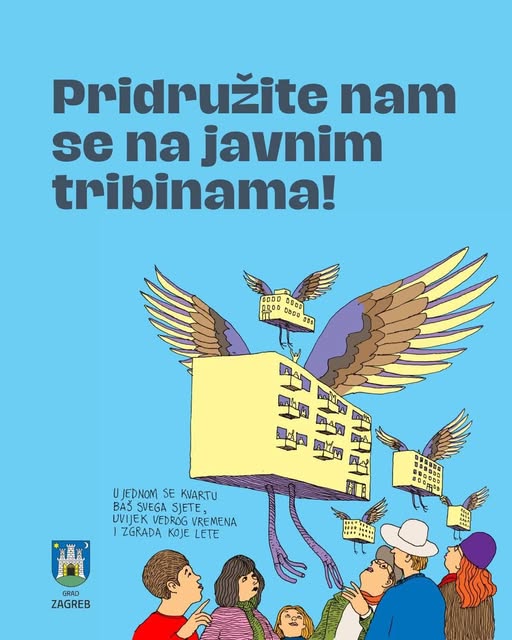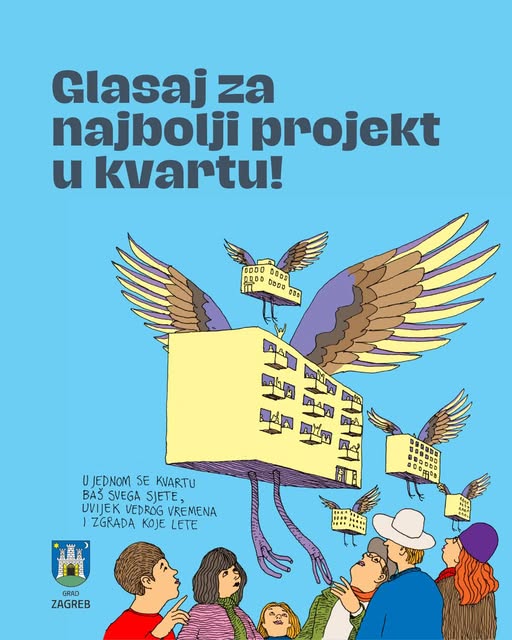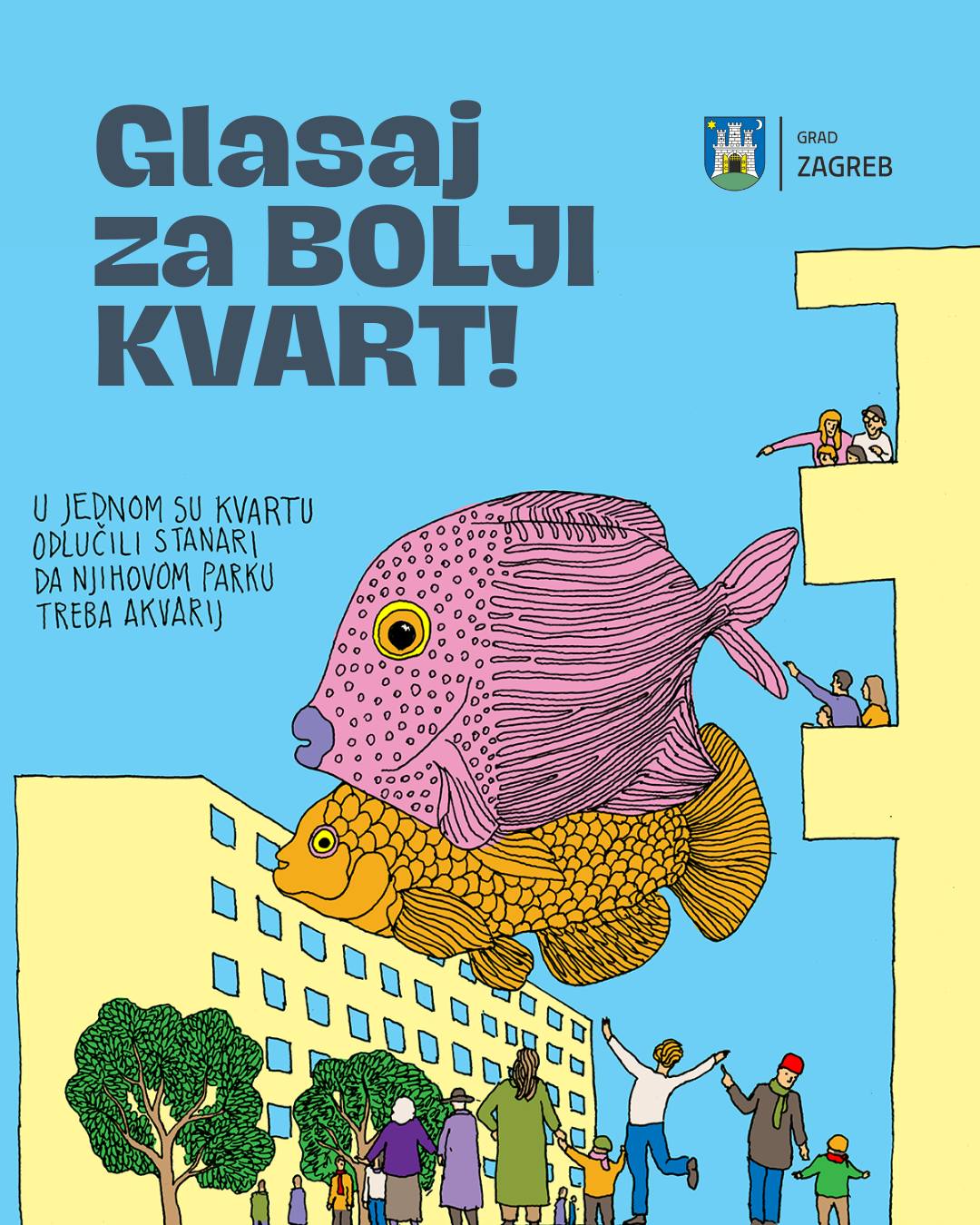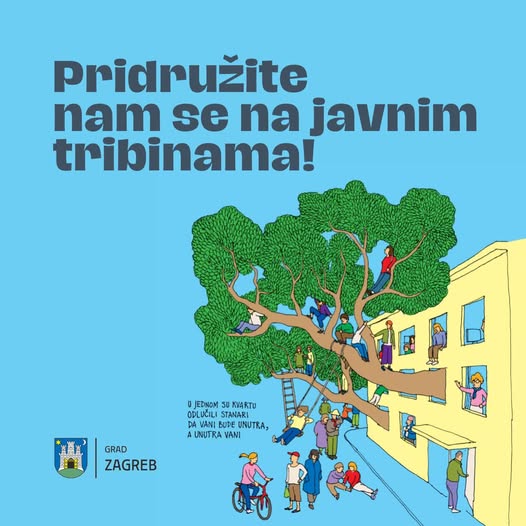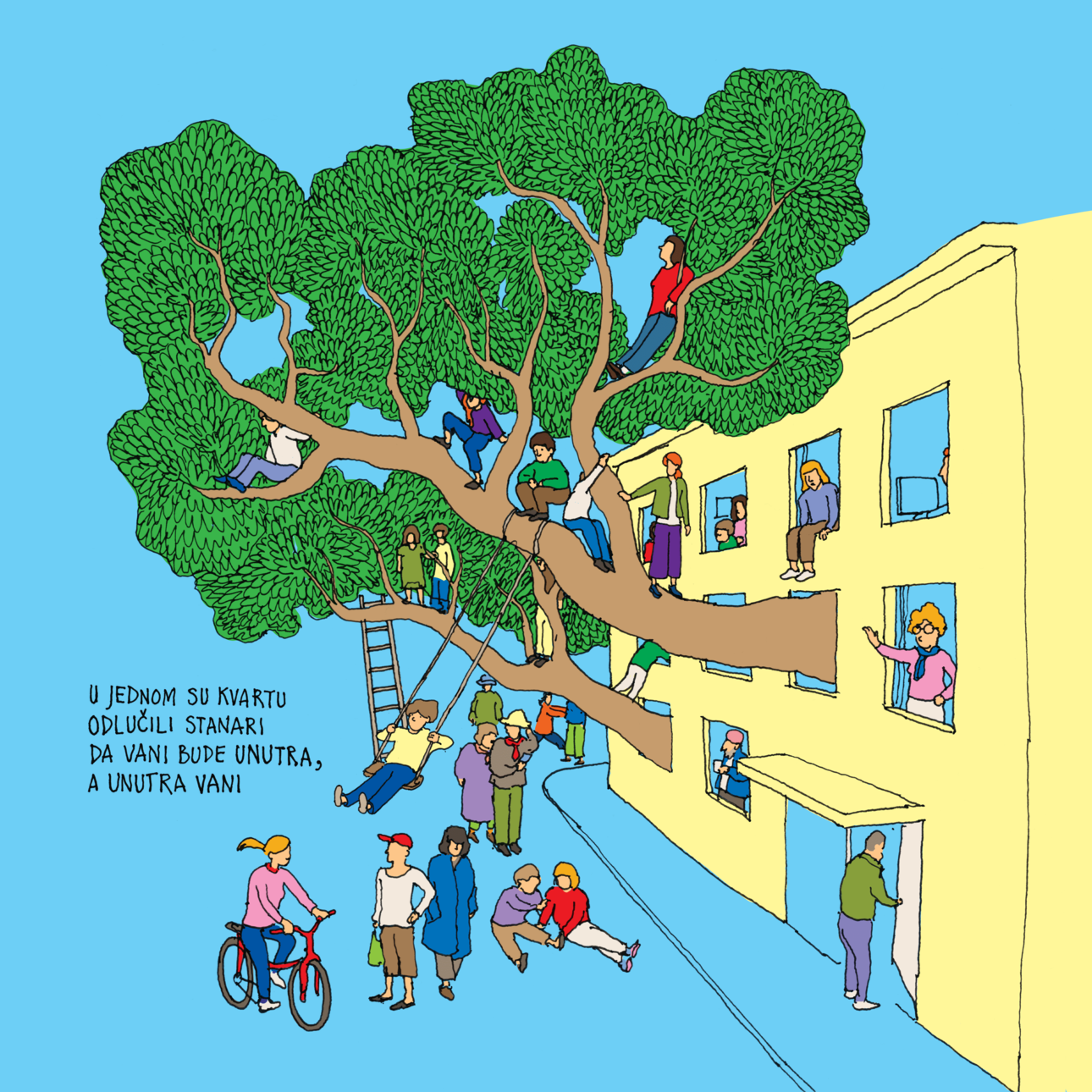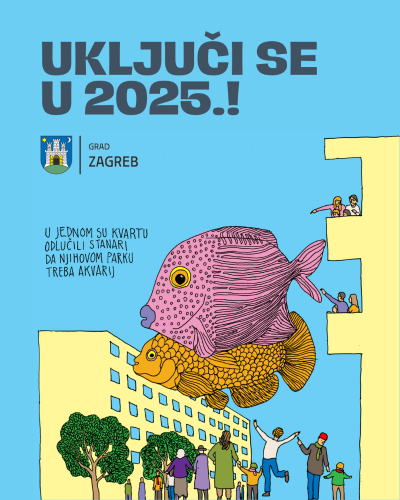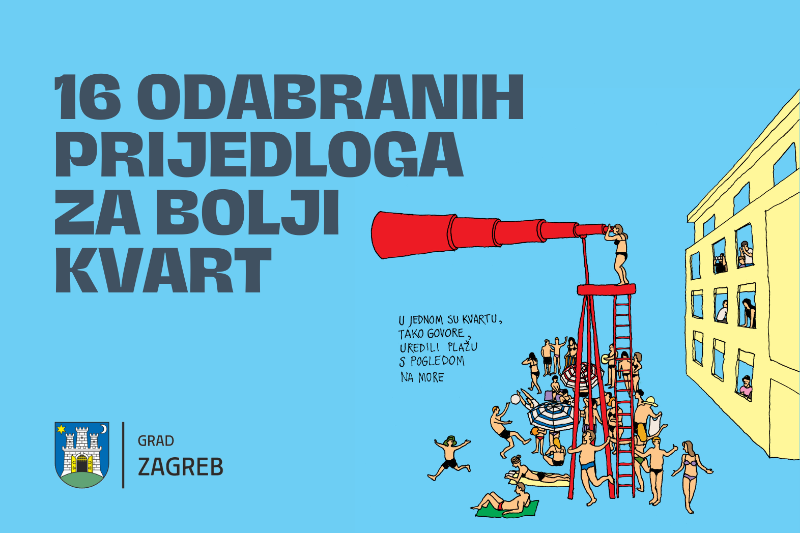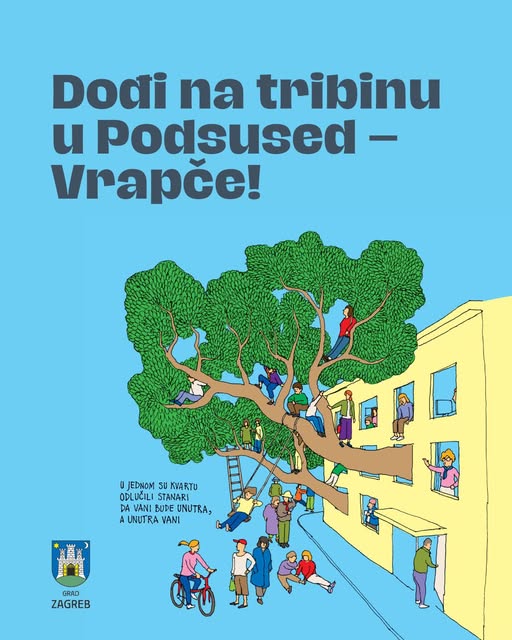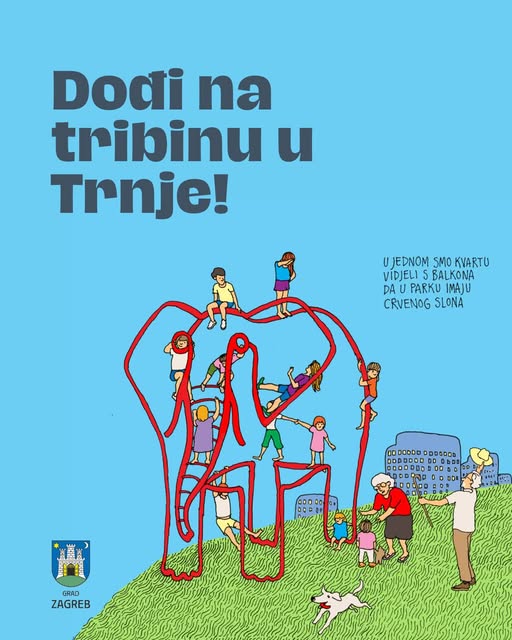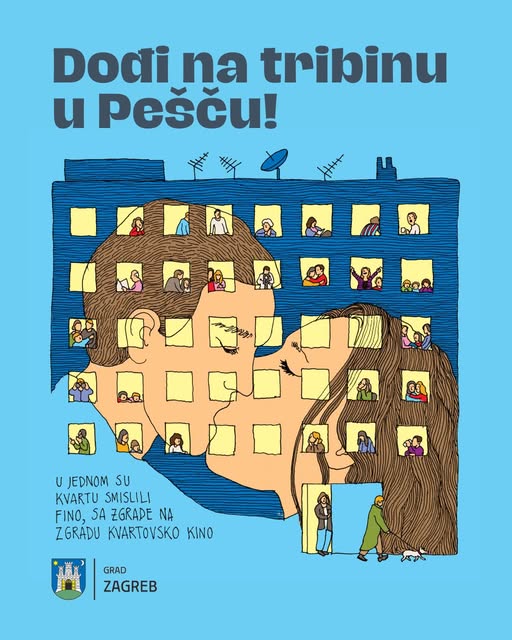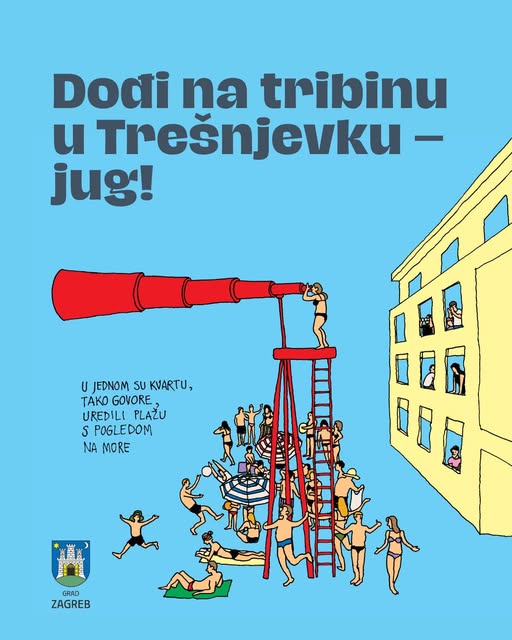Regaining a sense of belonging
"Suggest a Better Neighbourhood!"
"Suggest a Better Neighbourhood! e-Participatory budgeting pilot project"
In December 2024, the City of Zagreb completed the e-Participatory budgeting pilot project. Citizens chose 16 projects across four city districts. The process allowed citizens to propose and vote on solutions to neighborhood challenges, directly influencing how part of the public funds for city districts were spent. In October, projects were proposed, evaluated by district councils and experts, and voted on in November. Winning projects will be financed in 2025 using district council funds.
Croatia
Local
City of Zagreb
Mainly urban
It refers to other types of transformations (soft investment)
Yes
2024-12-13
No
No
No
As a representative of an organisation
In 2024. City of Zagreb conducted an e-participatory budgeting pilot project where citizens proposed communal projects via online platform they consider the most important for improving their neighbourhoods. Citizens then took part in selecting the best among them. Four district councils involved in this pilot (out of seventeen city districts in the City of Zagreb) allocated approximately 6% of their funds for this project. This innovative governance model enabled greater participation of community dwellers in helping to allocate a portion of public budget, thereby increasing the transparency and inclusiveness of the process. By being able to propose projects and select the best projects for their local communities, and then monitor project implementation, citizens gained a better understanding how public funds are being spent and they are becoming more active participants in the communal infrastructure planning. All of the projects selected by citizens were publicly announced as selected by community dwellers in this participatory process.
By focusing on local needs, project contributes to a more sustainable urban development, ensuring that projects are relevant and impactful in improving community infrastructure. Additionally, citizens can provide continuous feedback on projects, which improves future planning and ensures that city infrastructure is aligned with the community's changing needs.
The e-participatory budgeting project strengthens the sense of belonging and responsibility among residents, helping them take ownership of their local communites. It serves as an exemplary model of how participatory budgeting can foster transparency, inclusiveness and sustainability by creating an engaged, informed and empowered community dwellers. The project's success will lead to expansion across other city districts, increasing citizen involvement in shaping the future of their neighborhoods and contributing to more responsive and citizen-centric urban planning.
By focusing on local needs, project contributes to a more sustainable urban development, ensuring that projects are relevant and impactful in improving community infrastructure. Additionally, citizens can provide continuous feedback on projects, which improves future planning and ensures that city infrastructure is aligned with the community's changing needs.
The e-participatory budgeting project strengthens the sense of belonging and responsibility among residents, helping them take ownership of their local communites. It serves as an exemplary model of how participatory budgeting can foster transparency, inclusiveness and sustainability by creating an engaged, informed and empowered community dwellers. The project's success will lead to expansion across other city districts, increasing citizen involvement in shaping the future of their neighborhoods and contributing to more responsive and citizen-centric urban planning.
Engagement
Transparency
Collaboration
Empowerment
Inclusivity
The e-participatory budgeting project in the city of Zagreb focuses on sustainability by engaging citizens directly in decision-making, fostering long-term community involvement in local governance. Through proposing, selecting, and monitoring projects, citizens develop a sense of ownership and responsibility for their neighbourhoods, promoting a sustainable democratic process.
The project also strengthens social sustainability by encouraging collaboration among neighbourhoods and district councils. It fosters inclusivity by giving all citizens a voice in suggesting and voting on projects that impact their daily lives, enhancing social cohesion and community bonds.
Transparency and accountability are key objectives, as citizens can track the allocation and use of public funds for neighborhood improvements. This openness ensures that public resources are spent according to community priorities, promoting inclusive and transparent management of city’s funds.
Sustainable urban development is another goal, with projects’ addressing specific local needs, such as improving roads, parks and public spaces. Active citizen involvement ensures that the projects meet actual community needs, supporting long-term infrastructure improvements that benefit the neighbourhood.
Feedback and continuous improvement are integral to the project, allowing citizens to voice concerns and suggestions, which helps local councils and the City of Zagreb align future urban planning with the community's evolving needs. This feedback loop fosters a responsive and adaptive urban environment.
This project exemplifies sustainability by promoting citizen participation in urban planning, enhancing transparency and accountability in public spending, and fostering social cohesion. By addressing local needs and ensuring an inclusive process, it lays the foundation for a sustainable urban development and sense of a greater community ownership of local infrastructure.
The project also strengthens social sustainability by encouraging collaboration among neighbourhoods and district councils. It fosters inclusivity by giving all citizens a voice in suggesting and voting on projects that impact their daily lives, enhancing social cohesion and community bonds.
Transparency and accountability are key objectives, as citizens can track the allocation and use of public funds for neighborhood improvements. This openness ensures that public resources are spent according to community priorities, promoting inclusive and transparent management of city’s funds.
Sustainable urban development is another goal, with projects’ addressing specific local needs, such as improving roads, parks and public spaces. Active citizen involvement ensures that the projects meet actual community needs, supporting long-term infrastructure improvements that benefit the neighbourhood.
Feedback and continuous improvement are integral to the project, allowing citizens to voice concerns and suggestions, which helps local councils and the City of Zagreb align future urban planning with the community's evolving needs. This feedback loop fosters a responsive and adaptive urban environment.
This project exemplifies sustainability by promoting citizen participation in urban planning, enhancing transparency and accountability in public spending, and fostering social cohesion. By addressing local needs and ensuring an inclusive process, it lays the foundation for a sustainable urban development and sense of a greater community ownership of local infrastructure.
This project is exemplary because it combines aesthetic and cultural considerations with democratic processes. By ensuring that residents have a direct role in shaping the design and functionality of their public spaces, the project promotes a more harmonious relationship between people and their environments. Proposing projects, as well as voting, was made possible through an online ArcGIS geospatial platform (application via NIAS*) where citizens could mark the proposed location and briefly explain the project. It sets a standard for how participatory budgeting can be used to create urban spaces that are not only sustainable and functional, but also visually appealing and culturally meaningful. In addition to the web form, submission of proposals and voting was also possible in person at the headquarters of the city district. The success of this initiative highlights the potential for future projects to further enhance the quality of life for community dwellers through thoughtful, citizen-driven design and improvements.
*NIAS is a system that represents a national central point of identification and authentication of users when signing up for an e-service. Its core function is to provide electronic identification and authentication services safely and reliably using a credential.
*NIAS is a system that represents a national central point of identification and authentication of users when signing up for an e-service. Its core function is to provide electronic identification and authentication services safely and reliably using a credential.
The e-participatory budgeting pilot project in the City of Zagreb (2024) prioritizes inclusion by ensuring accessibility, affordability, and participation for all citizens in local decision-making. The key objectives in terms of inclusion are met by creating an inclusive platform for all citizens to engage with and influence the allocation of public funds for neighbourhood improvements. The project is exemplary in its approach to inclusion, as it not only creates an accessible platform for decision-making but also ensures that the outcomes of the project are representative of the community's diverse needs. By embracing inclusive governance, accessibility, and community-driven design, it serves as a model for how participatory budgeting can be a tool for promoting more equitable and inclusive urban development. The entire process was accompanied by public forums in the city's neighborhoods, where citizens were presented with the process of participatory budgeting and local self-government in the City of Zagreb, proposed projects as part of this year's pilot project, as well as selected projects that will be financed in 2025. Overall, city administration received 252 valid project proposals and, 73 proposals where evaluated and over 600 resident citizens voted out 16 projects worth 363.000,00 € to be implemented 2025. The success of this initiative can inspire other cities to adopt similar models, ensuring that future urban planning and community development efforts are truly inclusive and responsive to the needs of all citizens.
The City of Zagreb’s 2024 e-participatory budgeting pilot project enabled citizens to actively shape their neighbourhoods by proposing and selecting projects focused on infrastructure improvements such as roads, parks, and promenades.
Citizens played a central role at multiple stages: first, they proposed projects based on their community’s needs; next, they voted on the most impactful proposals; and finally, they monitor the implementation of the selected projects. This engagement increased their understanding of public fund allocation and empowered them to take ownership of their surroundings.
In terms of sustainability, the project ensured that investments directly addressed local priorities, contributing to long-term urban resilience and ecological well-being. The participatory approach enables continuous citizen feedback, allowing adjustments to be made in future planning to align with evolving community needs.
From an inclusion perspective, the initiative strengthened democratic participation by allowing all residents to contribute to decision-making. This model promoted civic engagement and equal representation, ensuring that diverse voices shape the urban environment. Aesthetically, the project led to improvements that enhances public spaces, making them more functional and visually appealing. By prioritizing community-driven initiatives, the project resulted in infrastructure developments that residents found meaningful and beneficial.
The direct involvement of citizens in planning and decision-making strengthened their sense of responsibility and belonging. Their participation ensured that projects were relevant and impactful, fostering a community-driven approach to urban development.
Citizens played a central role at multiple stages: first, they proposed projects based on their community’s needs; next, they voted on the most impactful proposals; and finally, they monitor the implementation of the selected projects. This engagement increased their understanding of public fund allocation and empowered them to take ownership of their surroundings.
In terms of sustainability, the project ensured that investments directly addressed local priorities, contributing to long-term urban resilience and ecological well-being. The participatory approach enables continuous citizen feedback, allowing adjustments to be made in future planning to align with evolving community needs.
From an inclusion perspective, the initiative strengthened democratic participation by allowing all residents to contribute to decision-making. This model promoted civic engagement and equal representation, ensuring that diverse voices shape the urban environment. Aesthetically, the project led to improvements that enhances public spaces, making them more functional and visually appealing. By prioritizing community-driven initiatives, the project resulted in infrastructure developments that residents found meaningful and beneficial.
The direct involvement of citizens in planning and decision-making strengthened their sense of responsibility and belonging. Their participation ensured that projects were relevant and impactful, fostering a community-driven approach to urban development.
Roles and levels of involvement of different stakeholders, engaged in the design and implementation of our e-participatory budgeting project, as follows:
District Councils
Role: Four district councils allocated approximately 6% of their budgets to fund the initiatives and provided administrative support.
Level of Involvement: They facilitated the process, allocated part of their budgets, and ensured project feasibility.
Added Value: Their involvement provided legitimacy and institutional support, helping align participatory budgeting with broader municipal planning.
City Administration
Role: The City of Zagreb, Information System and Technical Service and City Office for Municipal Self - Government, Transport, Civil Protection and Safety coordinated the initiative, providing the digital platform, logistical support and regulatory oversight.
Level of Involvement: They ensured that the whole process functions according to plan and deadlines, coordinated implementation of selected projects and ensured visibility of the pilot project.
Added Value: Their role enhanced transparency, ensured accountability, and streamlined project execution.
Ministry of Justice, Public Administration and Digital Transformation
Role: Provider central point of identification and authentication of users when signing up for an e-service (NIAS)
Level of Involvement: They ensured technical support for implementation of NIAS system on projects' ArcGIS geospatial digital platform.
Added Value: They made the electronic identification and authentication process faster and more reliable.
District Councils
Role: Four district councils allocated approximately 6% of their budgets to fund the initiatives and provided administrative support.
Level of Involvement: They facilitated the process, allocated part of their budgets, and ensured project feasibility.
Added Value: Their involvement provided legitimacy and institutional support, helping align participatory budgeting with broader municipal planning.
City Administration
Role: The City of Zagreb, Information System and Technical Service and City Office for Municipal Self - Government, Transport, Civil Protection and Safety coordinated the initiative, providing the digital platform, logistical support and regulatory oversight.
Level of Involvement: They ensured that the whole process functions according to plan and deadlines, coordinated implementation of selected projects and ensured visibility of the pilot project.
Added Value: Their role enhanced transparency, ensured accountability, and streamlined project execution.
Ministry of Justice, Public Administration and Digital Transformation
Role: Provider central point of identification and authentication of users when signing up for an e-service (NIAS)
Level of Involvement: They ensured technical support for implementation of NIAS system on projects' ArcGIS geospatial digital platform.
Added Value: They made the electronic identification and authentication process faster and more reliable.
Public Administration and Governance
o Ensured the project aligned with municipal policies, legal frameworks, and budgetary processes.
o Facilitated coordination between district councils, city authorities, and citizens to ensure smooth execution.
Urban Planning and Infrastructure Development
o Evaluated the feasibility of proposed projects to ensure they aligned with long-term city planning goals.
o Provided technical expertise on roadwork, park development, and public space improvements.
Digital Technology and E-Governance
o Detailed documented and analyzed business processes: Budget preparation, Citizens' suggestions, Evaluation, Voting, Municipal activities and Implementation in ARIS Repository
o Developed and maintained online platform where citizens proposed, voted and monitor progress of selected projects.
o Ensured accessibility and usability of digital tools for broad community participation.
Social Sciences and Community Engagement
o Applied principles from sociology and political science to enhance civic participation.
o Conducted outreach to diverse social groups to ensure inclusivity and representativeness in decision-making.
Environmental Sustainability
o Assessed projects for ecological impact and sustainability, ensuring alignment with green urban policies.
o Promoted nature-based solutions, such as park expansions and green infrastructure, to enhance urban resilience.
Added Value of this Process
The interdisciplinary approach resulted in a well-rounded project that balanced technical feasibility with community priorities. It ensured that selected projects were not only citizen-driven, but also structurally sound, environmentally sustainable and financially viable. The collaboration fostered innovation, transparency and accountability, leading to more engaged and empowered local communities. This integration of expertise demonstrated how participatory budgeting can serve as a model for inclusive and sustainable urban planning.
o Ensured the project aligned with municipal policies, legal frameworks, and budgetary processes.
o Facilitated coordination between district councils, city authorities, and citizens to ensure smooth execution.
Urban Planning and Infrastructure Development
o Evaluated the feasibility of proposed projects to ensure they aligned with long-term city planning goals.
o Provided technical expertise on roadwork, park development, and public space improvements.
Digital Technology and E-Governance
o Detailed documented and analyzed business processes: Budget preparation, Citizens' suggestions, Evaluation, Voting, Municipal activities and Implementation in ARIS Repository
o Developed and maintained online platform where citizens proposed, voted and monitor progress of selected projects.
o Ensured accessibility and usability of digital tools for broad community participation.
Social Sciences and Community Engagement
o Applied principles from sociology and political science to enhance civic participation.
o Conducted outreach to diverse social groups to ensure inclusivity and representativeness in decision-making.
Environmental Sustainability
o Assessed projects for ecological impact and sustainability, ensuring alignment with green urban policies.
o Promoted nature-based solutions, such as park expansions and green infrastructure, to enhance urban resilience.
Added Value of this Process
The interdisciplinary approach resulted in a well-rounded project that balanced technical feasibility with community priorities. It ensured that selected projects were not only citizen-driven, but also structurally sound, environmentally sustainable and financially viable. The collaboration fostered innovation, transparency and accountability, leading to more engaged and empowered local communities. This integration of expertise demonstrated how participatory budgeting can serve as a model for inclusive and sustainable urban planning.
Key Innovations Compared to Mainstream Approaches
Digital-First Citizen Participation
o Unlike standard budgeting processes, this project utilized an online platform, making participation more accessible and engaging.
o By digitizing the proposal and voting process, the initiative significantly lowered barriers to participation, allowing a broader demographic to take part, including younger more digitally oriented citizens.
Direct Democratic Decision-Making
o Traditional budgeting typically involves limited public input, often through indirect consultations or surveys. In contrast, this model enabled citizens to not only propose projects but also vote on them, ensuring that the final selection truly reflected community priorities. This approach increased accountability by making the decision-making process more visible and traceable.
Localized and Community-Driven Approach
o While municipal infrastructure planning usually follows centralized policies, this initiative focused on micro-local needs, ensuring that projects were relevant and beneficial to specific neighborhoods.
Continuous Citizen Feedback and Adaptive Planning
o Unlike static public investment plans, which are often finalized without further citizen input, this project established mechanisms for ongoing public feedback based on real local needs.
Stronger Sense of Ownership and Civic Engagement
o By engaging residents in all stages—from proposal to implementation—this project strengthened civic responsibility, fostering a deeper connection between the community and its environment.
Impact of Innovation
The introduction of this participatory model represents a shift towards more democratic, transparent and inclusive urban governance. By prioritizing citizen input, leveraging digital tools and creating a flexible feedback loop, the project demonstrated a scalable and replicable model that can enhance urban planning across other districts in Zagreb and beyond.
Digital-First Citizen Participation
o Unlike standard budgeting processes, this project utilized an online platform, making participation more accessible and engaging.
o By digitizing the proposal and voting process, the initiative significantly lowered barriers to participation, allowing a broader demographic to take part, including younger more digitally oriented citizens.
Direct Democratic Decision-Making
o Traditional budgeting typically involves limited public input, often through indirect consultations or surveys. In contrast, this model enabled citizens to not only propose projects but also vote on them, ensuring that the final selection truly reflected community priorities. This approach increased accountability by making the decision-making process more visible and traceable.
Localized and Community-Driven Approach
o While municipal infrastructure planning usually follows centralized policies, this initiative focused on micro-local needs, ensuring that projects were relevant and beneficial to specific neighborhoods.
Continuous Citizen Feedback and Adaptive Planning
o Unlike static public investment plans, which are often finalized without further citizen input, this project established mechanisms for ongoing public feedback based on real local needs.
Stronger Sense of Ownership and Civic Engagement
o By engaging residents in all stages—from proposal to implementation—this project strengthened civic responsibility, fostering a deeper connection between the community and its environment.
Impact of Innovation
The introduction of this participatory model represents a shift towards more democratic, transparent and inclusive urban governance. By prioritizing citizen input, leveraging digital tools and creating a flexible feedback loop, the project demonstrated a scalable and replicable model that can enhance urban planning across other districts in Zagreb and beyond.
Approach used:
Digital Platform for Proposal Submission
-Citizens were invited to submit project proposals through an online platform, which served as the primary interface for engagement.
-Proposals focused on improving local infrastructure (e.g. roads, parks, etc.) ensuring that submitted ideas align with the districts' development priorities.
Project Feasibility Assessment
-A team of city administrators and politically elected councilors reviewed the submitted proposals.
-Each project was evaluated based on feasibility, budget constraints, legal compliance.
-Proposals that met the criteria advanced to the next stage, ensuring that only actionable projects were put to a public vote.
Public Voting and Selection
-Citizens participated in an online voting process, selecting the projects they deemed most valuable for their community.
-This phase allowed for direct democratic participation, ensuring that the final allocation of funds reflected local priorities rather than top-down government planning.
Implementation and Monitoring
-Selected projects were publicly announced with clear timelines and allocated budgets. Citizens were encouraged to monitor the implementation progress.
-City of Zagreb managed the execution of the approved projects.
Continuous Feedback and Iteration
-The city administration collected insights from the process to refine future editions of participatory budgeting, ensuring its scalability and replicability.
Added Value of this Approach
By integrating digital tools, technical expertise and direct public involvement, this approach increased transparency, inclusiveness and accountability of budget allocation. The structured process empowered citizens to take ownership of urban planning, ensuring that projects reflect real community needs. The approach serves as a scalable model for future participatory budgeting initiatives, potentially expanding to other districts and reinforcing long-term civic engagement in local governance.
Digital Platform for Proposal Submission
-Citizens were invited to submit project proposals through an online platform, which served as the primary interface for engagement.
-Proposals focused on improving local infrastructure (e.g. roads, parks, etc.) ensuring that submitted ideas align with the districts' development priorities.
Project Feasibility Assessment
-A team of city administrators and politically elected councilors reviewed the submitted proposals.
-Each project was evaluated based on feasibility, budget constraints, legal compliance.
-Proposals that met the criteria advanced to the next stage, ensuring that only actionable projects were put to a public vote.
Public Voting and Selection
-Citizens participated in an online voting process, selecting the projects they deemed most valuable for their community.
-This phase allowed for direct democratic participation, ensuring that the final allocation of funds reflected local priorities rather than top-down government planning.
Implementation and Monitoring
-Selected projects were publicly announced with clear timelines and allocated budgets. Citizens were encouraged to monitor the implementation progress.
-City of Zagreb managed the execution of the approved projects.
Continuous Feedback and Iteration
-The city administration collected insights from the process to refine future editions of participatory budgeting, ensuring its scalability and replicability.
Added Value of this Approach
By integrating digital tools, technical expertise and direct public involvement, this approach increased transparency, inclusiveness and accountability of budget allocation. The structured process empowered citizens to take ownership of urban planning, ensuring that projects reflect real community needs. The approach serves as a scalable model for future participatory budgeting initiatives, potentially expanding to other districts and reinforcing long-term civic engagement in local governance.
The elements behind high transferability and replicability potential of this project: Digital Participatory Platform
-The use of an online platform for project submission, voting, and feedback can be easily adapted to different cities and municipalities.
-This technology enables remote participation, making the process more inclusive and accessible
Community-Driven Budget Allocation
-The methodology of allocating a percentage of public funds for citizen-selected projects can be implemented in different governance structures
-The percentage of allocated funds can be adjusted based on local budgetary constraints, making it adaptable to different financial contexts.
Structured Citizen Engagement Process
-The phased approach provides a clear and replicable framework for participatory decision-making.
-This structure ensures that participatory budgeting is transparent, democratic, and effective, regardless of the location.
Multi-Stakeholder Collaboration
-The integration of urban planners, public administrators, digital technology experts, and community groups can be mirrored in other municipalities
-The project demonstrates how cooperation between citizens and government leads to more responsive urban planning, a principle applicable to various governance models.
Sustainability and Scalability
-The model can be expanded to include projects related to climate action, public transport, cultural initiatives, and social services, making it adaptable beyond infrastructure.
Potential Transfer to Other Contexts
Other cities: The process can be replicated in different urban environments, from small towns to large metropolitan areas.
Different beneficiary groups: Adaptation to specific groups (e.g., youth councils, senior citizens, marginalized communities) ensures inclusive participation in diverse social settings.
Private sector & institutions: The model can be applied by businesses, universities and NGO's to allocate their budgets more democratically.
-The use of an online platform for project submission, voting, and feedback can be easily adapted to different cities and municipalities.
-This technology enables remote participation, making the process more inclusive and accessible
Community-Driven Budget Allocation
-The methodology of allocating a percentage of public funds for citizen-selected projects can be implemented in different governance structures
-The percentage of allocated funds can be adjusted based on local budgetary constraints, making it adaptable to different financial contexts.
Structured Citizen Engagement Process
-The phased approach provides a clear and replicable framework for participatory decision-making.
-This structure ensures that participatory budgeting is transparent, democratic, and effective, regardless of the location.
Multi-Stakeholder Collaboration
-The integration of urban planners, public administrators, digital technology experts, and community groups can be mirrored in other municipalities
-The project demonstrates how cooperation between citizens and government leads to more responsive urban planning, a principle applicable to various governance models.
Sustainability and Scalability
-The model can be expanded to include projects related to climate action, public transport, cultural initiatives, and social services, making it adaptable beyond infrastructure.
Potential Transfer to Other Contexts
Other cities: The process can be replicated in different urban environments, from small towns to large metropolitan areas.
Different beneficiary groups: Adaptation to specific groups (e.g., youth councils, senior citizens, marginalized communities) ensures inclusive participation in diverse social settings.
Private sector & institutions: The model can be applied by businesses, universities and NGO's to allocate their budgets more democratically.
Project provided:
Democratic Deficit & Citizen Engagement
Global Challenge: Many communities worldwide experience a lack of direct citizen involvement in decision-making, leading to political disengagement and dissatisfaction with governance.
Local Solution: By allowing citizens to propose, vote on, and monitor projects, the e-Participatory Budgeting initiative empowers communities, strengthens democracy, and fosters active civic participation.
Lack of Transparency and Trust in Government
Global Challenge: Corruption and lack of accountability in public spending undermine trust in government institutions.
Local Solution: The project promotes financial transparency by publicly sharing budget allocations, project selection, and implementation updates, ensuring that public funds are used effectively and accountably.
Urban Sustainability & Infrastructure Development
Global Challenge: Many cities struggle with aging infrastructure, inefficient urban planning, and environmental degradation.
Local Solution: The initiative directs funds to locally identified needs ensuring infrastructure projects are sustainable, efficient, and aligned with community priorities.
Social Inequality & Inclusion
Global Challenge: Marginalized groups often lack access to decision-making processes and essential urban services.
Local Solution: The participatory budgeting model ensures equitable distribution of resources, enabling all citizens—regardless of social or economic status—to have a say in local development. The digital platform also enhances accessibility for groups with limited mobility.
Weak Feedback Mechanisms in Public Administration
Global Challenge: Traditional governance models often lack structured citizen feedback mechanisms, resulting in policies that do not align with real community needs.
Local Solution: The project establishes a continuous feedback loop, allowing residents to monitor progress and influence future public spending decisions.
Democratic Deficit & Citizen Engagement
Global Challenge: Many communities worldwide experience a lack of direct citizen involvement in decision-making, leading to political disengagement and dissatisfaction with governance.
Local Solution: By allowing citizens to propose, vote on, and monitor projects, the e-Participatory Budgeting initiative empowers communities, strengthens democracy, and fosters active civic participation.
Lack of Transparency and Trust in Government
Global Challenge: Corruption and lack of accountability in public spending undermine trust in government institutions.
Local Solution: The project promotes financial transparency by publicly sharing budget allocations, project selection, and implementation updates, ensuring that public funds are used effectively and accountably.
Urban Sustainability & Infrastructure Development
Global Challenge: Many cities struggle with aging infrastructure, inefficient urban planning, and environmental degradation.
Local Solution: The initiative directs funds to locally identified needs ensuring infrastructure projects are sustainable, efficient, and aligned with community priorities.
Social Inequality & Inclusion
Global Challenge: Marginalized groups often lack access to decision-making processes and essential urban services.
Local Solution: The participatory budgeting model ensures equitable distribution of resources, enabling all citizens—regardless of social or economic status—to have a say in local development. The digital platform also enhances accessibility for groups with limited mobility.
Weak Feedback Mechanisms in Public Administration
Global Challenge: Traditional governance models often lack structured citizen feedback mechanisms, resulting in policies that do not align with real community needs.
Local Solution: The project establishes a continuous feedback loop, allowing residents to monitor progress and influence future public spending decisions.
By providing an inclusive platform for co-creation and collective decision-making, this project has significantly contributed to regaining a sense of belonging among residents. Fostering community engagement, shared decision-making and collective ownership over local infrastructure development. Through active participation in proposing, selecting and monitoring projects, citizens have:
Reinforced community bonds
The project encouraged collaboration between neighbors, as citizens worked together to identify priority projects, discuss solutions, and vote for initiatives that benefit the entire community.
Public discussions, both online and in person, provided a platform for residents to connect, reinforcing a shared identity and a sense of purpose in improving their surroundings.
Increased civic engagement and empowerment
By allowing residents to directly influence public spending, the initiative empowered individuals who may have previously felt disconnected from decision-making processes.
The transparency and inclusiveness of the process enhanced trust in local governance, making citizens feel that their voices matter in shaping the future of their neighborhoods.
Made visible and tangible neighbourhood improvements
The implementation of citizen-selected projects provided immediate and meaningful benefits for residents.
Seeing their chosen projects realized reinforced a sense of achievement and belonging, proving that collective action leads to tangible improvements.
Impacted on direct and indirect beneficiaries w/ positive social impact
Direct Beneficiaries: Residents of four city districts' where projects were implemented experienced improved public spaces, accessibility and infrastructure, enhancing their daily quality of life.
Indirect Beneficiaries: The broader city population benefited from the model's long-term impact—encouraging future participatory governance initiatives and inspiring other communities to take ownership of their neighborhoods.
Reinforced community bonds
The project encouraged collaboration between neighbors, as citizens worked together to identify priority projects, discuss solutions, and vote for initiatives that benefit the entire community.
Public discussions, both online and in person, provided a platform for residents to connect, reinforcing a shared identity and a sense of purpose in improving their surroundings.
Increased civic engagement and empowerment
By allowing residents to directly influence public spending, the initiative empowered individuals who may have previously felt disconnected from decision-making processes.
The transparency and inclusiveness of the process enhanced trust in local governance, making citizens feel that their voices matter in shaping the future of their neighborhoods.
Made visible and tangible neighbourhood improvements
The implementation of citizen-selected projects provided immediate and meaningful benefits for residents.
Seeing their chosen projects realized reinforced a sense of achievement and belonging, proving that collective action leads to tangible improvements.
Impacted on direct and indirect beneficiaries w/ positive social impact
Direct Beneficiaries: Residents of four city districts' where projects were implemented experienced improved public spaces, accessibility and infrastructure, enhancing their daily quality of life.
Indirect Beneficiaries: The broader city population benefited from the model's long-term impact—encouraging future participatory governance initiatives and inspiring other communities to take ownership of their neighborhoods.




